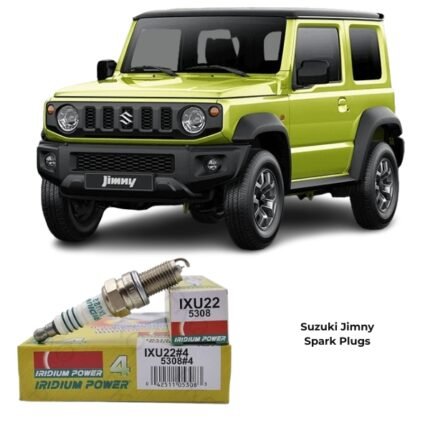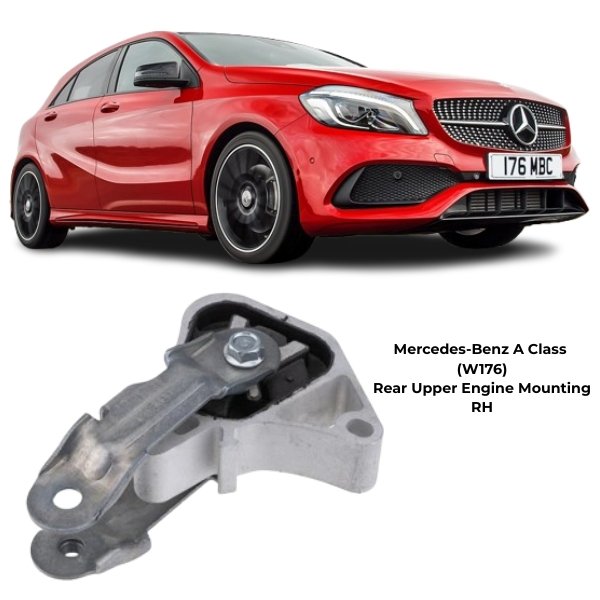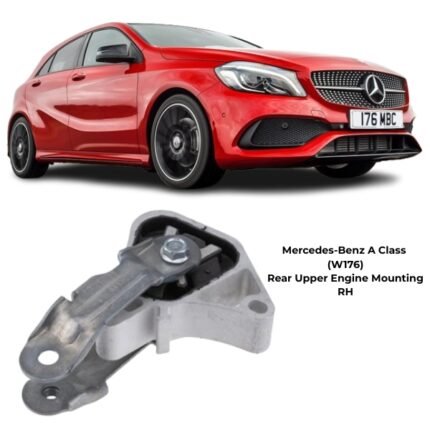Get Mercedes-Benz A Class (W176) Rear Upper Engine Mounting RH ZPS-ME-054 in Kenya
The Rear Upper Engine Mounting RH is a crucial component in a vehicle’s engine support system, designed to provide stability, reduce vibrations, and ensure smooth power transmission between the engine and the chassis. It plays a silent yet significant role in maintaining the comfort, balance, and longevity of both the engine and the vehicle’s overall structure. While often unnoticed, this mount is a vital part of the intricate network that keeps your vehicle running quietly and efficiently.
1. Understanding the Function of the Rear Upper Engine Mounting RH
The engine mounting system typically comprises several mounts strategically positioned around the engine and transmission. Each mount has a specific role depending on its location. The Rear Upper Engine Mounting RH (Right-Hand) supports the upper section of the engine on the right-hand side toward the rear of the engine bay.
Its main functions include:
-
Support and Stability: It holds the engine securely in place within the chassis, preventing excess movement when the vehicle is accelerating, decelerating, or driving over uneven terrain.
-
Vibration Damping: The mount acts as a cushion between the metal components of the engine and the body, absorbing and minimizing vibrations that would otherwise transfer into the cabin.
-
Alignment Maintenance: It helps maintain precise alignment between the engine and transmission, ensuring efficient torque transfer and smooth gear engagement.
-
Noise Reduction: By dampening vibrations, it contributes to a quieter cabin environment and reduces rattling or knocking sounds that can result from engine motion.
2. Construction and Material Composition
The Rear Upper Engine Mounting RH is engineered using durable materials designed to withstand high levels of stress, temperature, and vibration. Common construction features include:
-
Metal Brackets: Typically made of steel or aluminum, the brackets provide the structural support needed to hold the engine in place.
-
Rubber or Elastomer Core: The inner section consists of high-density rubber or polyurethane that acts as the main damping medium. This elastic material allows for controlled flexibility and absorbs shocks caused by engine movement.
-
Bonded Design: The rubber is vulcanized or bonded between two metal plates, creating a single strong unit capable of resisting tearing or separation even under extreme load.
-
Reinforced Mounting Points: The bolt holes and attachment points are reinforced to ensure a firm connection to the chassis and engine without loosening over time.
In modern vehicles, some mounts are hydraulic or active, featuring fluid chambers or electronically controlled systems that adjust damping stiffness based on driving conditions. However, the Rear Upper Engine Mounting RH in many vehicles is a solid rubber or hydraulic hybrid type designed for durability and balance.
3. How It Works
When the engine operates, it generates torque and vibrations due to combustion and rotational forces. These vibrations, if not controlled, can create noise, discomfort, and premature wear on surrounding parts.
The Rear Upper Engine Mounting RH functions as a buffer. The rubber or hydraulic material inside flexes and compresses slightly, absorbing the movement caused by engine torque and road irregularities. This prevents the engine from rocking back and forth excessively.
During acceleration, the engine tends to twist in the opposite direction of the drive wheels. The mount counteracts this twisting motion, keeping the powertrain stable. When idling, it isolates minor vibrations, ensuring the cabin remains calm and free from tremors.
4. Symptoms of a Faulty Rear Upper Engine Mounting RH
Like any other automotive component, engine mounts wear out over time due to heat, oil contamination, and mechanical stress. Common signs that the Rear Upper Engine Mounting RH may be failing include:
-
Excessive Engine Movement: You may notice the engine shaking or shifting noticeably when accelerating or changing gears.
-
Vibration in Cabin: Increased vibration through the steering wheel, floor, or dashboard during idling or driving.
-
Clunking or Banging Noises: Metallic knocking sounds when starting, braking, or during gear shifts can indicate that the mount has loosened or the rubber has deteriorated.
-
Visible Wear or Cracks: Physical inspection may reveal cracks, splits, or sagging in the rubber portion of the mount.
-
Engine Misalignment: The engine may appear tilted or uneven, affecting the alignment of drive belts or exhaust connections.
Ignoring these symptoms can lead to more severe mechanical issues, including damage to the exhaust system, transmission mounts, or engine brackets.
5. Importance of Timely Replacement
A damaged or worn Rear Upper Engine Mounting RH compromises not only comfort but also the structural integrity of the powertrain. Timely replacement ensures:
-
Smooth Operation: Restores proper engine balance and minimizes vibrations.
-
Extended Engine Life: Reduces stress on engine components and prevents cracking of manifolds or hoses.
-
Improved Driving Comfort: Keeps the vehicle cabin quiet and stable.
-
Safety: Ensures the engine remains securely anchored during sudden stops or impacts.
Replacing the mount at the first sign of wear prevents further damage and keeps repair costs manageable.
6. Installation Overview
While installation should ideally be performed by a professional mechanic, understanding the basic process helps in appreciating the mount’s placement and function.
-
Support the Engine: The engine is supported using a jack and wooden block or a specialized engine hoist to prevent it from dropping once the mount is removed.
-
Locate the Mount: The rear upper right-hand mount is found near the upper back section of the engine bay, bolted to the chassis and engine bracket.
-
Remove Old Mount: The bolts are loosened and the worn mount is detached carefully.
-
Install New Mount: The new mount is aligned correctly and bolted securely in place using manufacturer-specified torque.
-
Inspect and Test: After installation, the engine is started and checked for excessive movement or vibration to confirm proper fitment.
Regular inspection during servicing helps detect early signs of wear before failure occurs.
7. Maintenance and Longevity Tips
Although engine mounts are designed for long service life, their durability depends on driving habits and maintenance practices. To extend the lifespan of your Rear Upper Engine Mounting RH:
-
Avoid Aggressive Driving: Hard acceleration and sudden braking increase stress on the mounts.
-
Keep Engine Area Clean: Oil leaks can degrade rubber components over time.
-
Regular Inspection: Have mounts checked every 40,000 to 60,000 kilometers during routine service.
-
Replace in Pairs (if needed): When one mount fails, others may be close to wearing out; replacing them together restores full balance.
-
Use Quality Parts: Always choose durable, OEM-standard mounts for reliability and performance.
8. Technical Benefits of a Good Rear Upper Engine Mount
A high-quality mount enhances vehicle dynamics in several ways:
-
Reduced Vibrations and Noise Levels.
-
Improved Transmission Shift Smoothness.
-
Better Handling Stability due to controlled engine motion.
-
Reduced Wear on Adjacent Parts, including exhaust pipes, hoses, and wiring harnesses.
-
Enhanced Comfort for passengers and driver alike.
Follow us on Facebook for more parts.





Reviews
Clear filtersThere are no reviews yet.